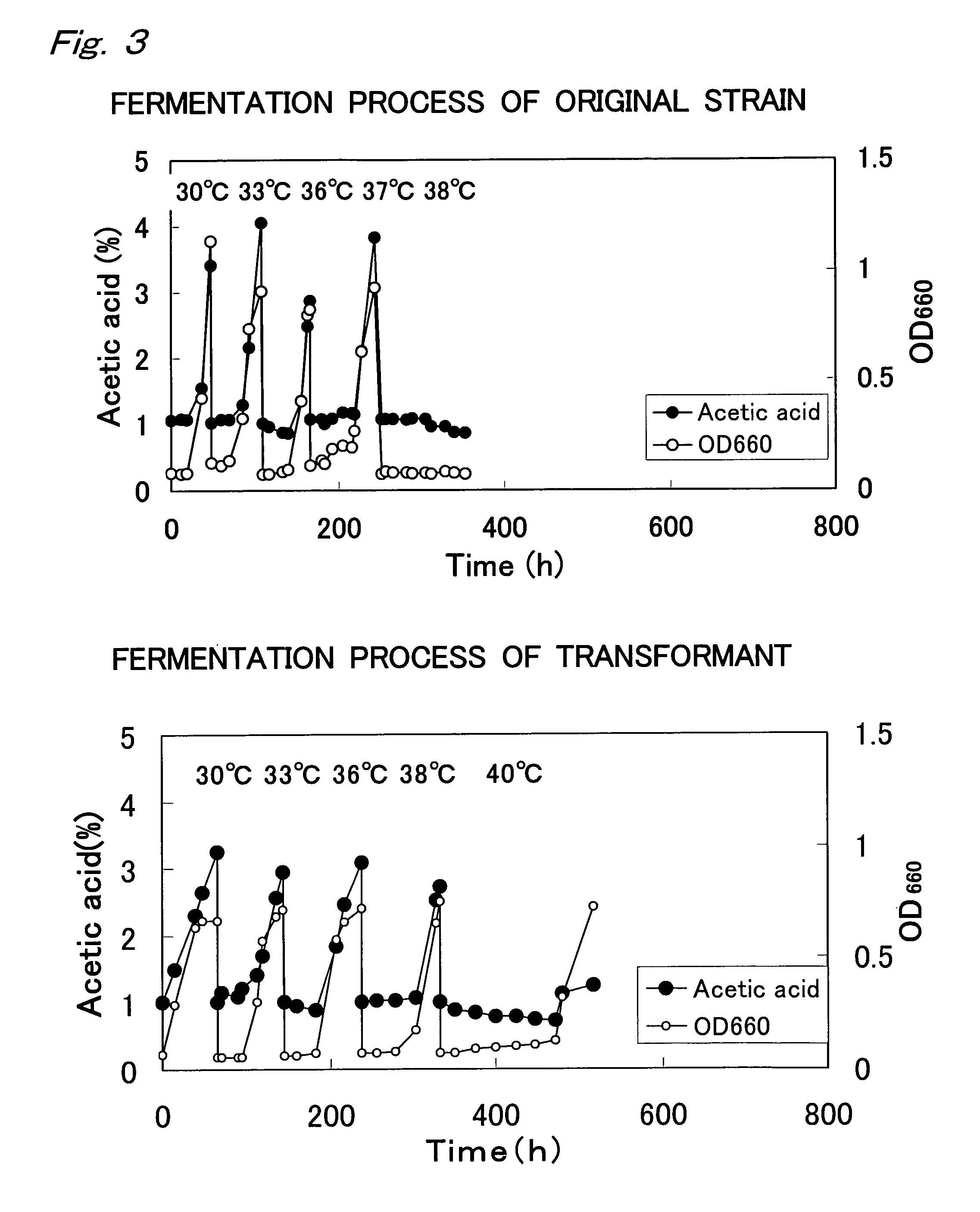Gene improving temperature-tolerance of acetic acid bacterium, acetic acid bacterium bred using the gene and process for producing vinegar using the acetic acid bacterium
a technology of acetic acid bacterium and temperature tolerance, which is applied in the direction of enzymology, organic chemistry, transferases, etc., can solve the problems of large amount of heat generated by fermentation, increased temperature in fermentation liquid, and needing cooling energy, so as to improve tolerance against temperature and achieve the effect of efficiently accumulating acetic acid even, providing and enhancing toleran
- Summary
- Abstract
- Description
- Claims
- Application Information
AI Technical Summary
Benefits of technology
Problems solved by technology
Method used
Image
Examples
example 1
Cloning of Temperature-Tolerance Gene from Gluconacetobacter entanii and Determination of the Nucleotide Sequence and the Amino Acid Sequence
(1) Generation of Chromosomal DNA Library
[0092]Acetobacter altoacetigenes MH-24 strain (FERM BP-491), which is one strain of Gluconacetobacter entanii, was cultured with shaking at 30° C. for 240 to 336 h in YPG medium (containing 3% glucose, 0.5% yeast extract and 0.2% polypeptone) to which 6% acetic acid and 4% ethanol were added. After the cultivation, the culture medium was centrifuged (7,500×g, 10 min) and bacterial cells were obtained. Chromosomal DNA was prepared from the obtained bacterial cells by the method disclosed in Japanese Laid-Open Patent Application No. 60-9489.
[0093]The obtained chromosomal DNA as mentioned above and the Escherichia coli-acetic acid bacteria shuttle vector pMV24 were digested with restriction enzymes SalI and KpnI (manufactured by Takara Bio Inc). These DNA in adequate amounts were mixed and ligated by using ...
example 2
Enhancement of Temperature Tolerance in Transformant Transformed with Temperature-Tolerance Gene Derived from Gluconacetobacter entanii
(1) Transformation of Acetobacter aceti
[0099]The gene for enhancing temperature tolerance derived from Acetobacter altoacetigenes MH-24 strain (FERM BP-491) cloned as in Example 1 described above was amplified by the PCR method using KOD-Plus- (manufactured by TOYOBO Co., LTD). Then, PGCS was constructed by inserting the amplified fragment into the restriction enzyme SmaI cleavage site of the acetic acid bacteria-Escherichia coli shuttle vector pMV24 (see non-patent literature 3, for instance). The outline of the amplified fragment inserted into pGCS is shown in FIG. 1. This amplified fragment is included in the SalI-KpnI fragment (gene for improving temperature tolerance: the nucleotide sequence thereof is shown in SEQ. ID No. 1), and includes a part of the upstream and the downstream regions of the coding region (ORF) of the nucleotides 73 to 125...
example 3
Acetic Acid Fermentation Test of the Transformant Transformed with Temperature-Tolerance Gene Derived from Gluconacetobacter entanii
(1) Temperature Tolerance of the Transformant
[0104]The ampicillin-resistant transformant having the plasmid pGCS obtained in Example 2 was compared with the original strain of Acetobacter aceti No. 1023 into which only the shuttle vector pMV24 was introduced with regard to the growth in YPG medium when the culture temperature was changed.
[0105]Specifically, aeration-agitation culture was carried out in 1 L of YPG medium containing 1% acetic acid, 4% ethanol and 100 μg / ml of ampicillin using a 2-L mini-jar fermenter (Mitsuwa Rikagaku Kogyo Co.; KMJ-2A) at 400 rpm and 0.2 vvm, and the concentration of acetic acid in the culture medium and the growth for the transformant (by measuring the absorbance at 660 nm) was compared to those for the original strain. The culture temperature was 30° C. at first, then fermentation was performed at 33° C. until the con...
PUM
| Property | Measurement | Unit |
|---|---|---|
| temperature | aaaaa | aaaaa |
| temperature | aaaaa | aaaaa |
| temperature | aaaaa | aaaaa |
Abstract
Description
Claims
Application Information
 Login to View More
Login to View More - R&D
- Intellectual Property
- Life Sciences
- Materials
- Tech Scout
- Unparalleled Data Quality
- Higher Quality Content
- 60% Fewer Hallucinations
Browse by: Latest US Patents, China's latest patents, Technical Efficacy Thesaurus, Application Domain, Technology Topic, Popular Technical Reports.
© 2025 PatSnap. All rights reserved.Legal|Privacy policy|Modern Slavery Act Transparency Statement|Sitemap|About US| Contact US: help@patsnap.com



